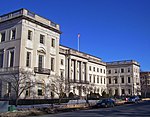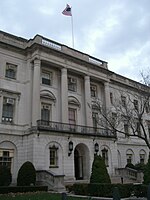WATR (1320 AM) is a radio station licensed to serve Waterbury, Connecticut, and the Naugatuck Valley. The station is owned by WATR Radio, LLC. It airs a full-service format featuring news–talk, as well as classic and modern hits. It was until May 2022 the oldest privately owned station in the state of Connecticut, never having been sold outside the family of its founder, Harold Thomas (1902–1968).
The station's weekday AM drive program is "Mornings with Chris & Allison", hosted by Christopher M. Fortier and Allison Demers, with news reports from veteran broadcaster Nancy Barrow. Fortier, former WATR news director, was appointed the station's Director of Operations & Programming on September 16, 2023, and began hosting the morning program on October 2, 2023 (Demers joined him one week later).
Barbara Hart Davitt, who marked 60 years at the station on November 22, 2023, hosts "Coffee Break" at 9:30 a.m. four days a week. Debuting in the mid-1960s, it is one of the longest-running radio shows in the U.S. Davitt in 2018 was the first Waterbury-area radio personality inducted into the Connecticut Broadcasters Association Hall of Fame.
"Talk of the Town", WATR's flagship talk show since 1972, airs from 10:00 a.m. to noon, with a focus on local and state issues. Previous hosts include Steven Noxon, Larry Rifkin, Ed Flynn, James Senich and Jay Clark.
The station, as of January 14, 2023, is an ABC News Radio affiliate.
Weekend programming highlights include the syndicated "Greatest Hits USA", hosted by Chuck Matthews; the Sunday morning "Carosello Italiano," hosted by Joe Costa and featuring music and news from the Italian community; and the Sunday night "Music Museum" hosted by longtime Connecticut broadcaster Jay Crawford.
The station was also host to the popular "Polish Eagle Show", originated in 1934 on WATR by bandleader Victor Zembruski (1912–1976). His widow, Sophie Zembruski (1918–2010), hosted the show from 1976 to 2008, at which time the couple's daughter, Loretta Hoxie, took over hosting duties. "The Zembruski Family Polka Hour", hosted by Nathaniel Zembruski, succeeded Hoxie shortly after she retired in 2013. Zembruski, at age 17, decided to end the show as his junior year of high school concluded. Its finale aired on May 31, 2020.
The station also maintains a decades-long tradition of broadcasting play-by-play of local high school football and basketball. WATR was a member of the University of Connecticut sports radio network from 2018 to 2023.
WATR once had sister FM and television stations: WATR-FM (now WWYZ), established in 1961, and WATR-TV (now WCCT-TV), established in 1953.
It was announced on February 24, 2020, that the station was up for sale. A partnership between WWCO owner David Webster and WARE owner Kurt Jackson purchased the station and translator W249DY effective August 24, 2022, for $320,000.The station has been assigned the WATR call letters by the Federal Communications Commission since it was initially licensed in 1934.








